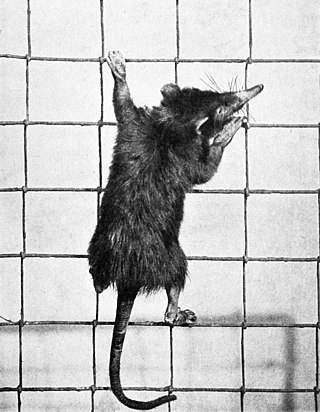
The Cuban solenodon or almiquí is a small, furry, shrew-like mammal endemic to mountainous forests on Cuba. It is the only species in the genus Atopogale. An elusive animal, it lives in burrows and is only active at night when it uses its unusual toxic saliva to feed on insects. The solenodons, native to the Caribbean, are one of only a few mammals that are venomous.
Lasiocroton is a plant genus of the family Euphorbiaceae first described as a genus in 1859. The genus is endemic to the West Indies. It is a member of the Leucocroton alliance, which also includes Leucocroton and Garciadelia. Species in this alliance are dioecious.
- Lasiocroton bahamensisPax & K.Hoffm. - Bahamas, Cuba, Haiti
- Lasiocroton fawcettiiUrb. - Jamaica
- Lasiocroton gracilisBritton & P.Wilson - SE Cuba
- Lasiocroton gutierreziiJestrow - Cuba
- Lasiocroton harrisiiBritton - Jamaica
- Lasiocroton macrophyllus(Sw.) Griseb. - Jamaica
- Lasiocroton microphyllus(A.Rich.) Jestrow - Cuba
- moved to other genera (Bernardia Croton Leucocroton)
- Lasiocroton cordifoliusBritton & P.Wilson - Leucocroton cordifolius (Britton & P.Wilson) Alain
- Lasiocroton prunifoliusGriseb. - Croton punctatusJacq.
- Lasiocroton subpeltatusUrb. - Leucocroton subpeltatus(Urb.) Alain
- Lasiocroton trelawniensisC.D.Adams - Bernardia trelawniensis(C.D.Adams) Jestrow & Proctor
Bernardia is a plant genus of the family Euphorbiaceae first described for modern science as a genus in 1754. It is native to North and South America, as well as the West Indies.

Chaetocarpus is a plant genus of the family Peraceae, formerly Euphorbiaceae, first described as a genus in 1854. Chaetocarpus species are trees or shrubs. They are native to the Americas, Africa, and Asia. Some species are endangered.
- Chaetocarpus acutifolius(Britton & P.Wilson) Borhidi – Sierra de Moa in Cuba
- Chaetocarpus africanusPax – C Africa
- Chaetocarpus castanocarpus(Roxb.) Thwaites – SE Asia, Yunnan, Assam, Bangladesh, Sri Lanka
- Chaetocarpus cordifolius(Urb.) Borhidi – Cuba, Hispaniola, Jamaica
- Chaetocarpus coriaceusThwaites – Sri Lanka
- Chaetocarpus cubensisFawc. & Rendle – Cuba
- Chaetocarpus echinocarpus (Baill.) Ducke – Bolivia, Brazil
- Chaetocarpus ferrugineusPhilcox – Sri Lanka
- Chaetocarpus gabonensisBreteler – Gabon
- Chaetocarpus globosus(Sw.) Fawc. & Rendle – Jamaica, Cuba, Dominican Rep.
- Chaetocarpus myrsinitesBaill. – Bolivia, Brazil
- Chaetocarpus parvifoliusBorhidi – Cuba
- Chaetocarpus pearceiRusby – Bolivia
- Chaetocarpus pubescens(Thwaites) Hook.f. – Sri Lanka
- Chaetocarpus rabarabaCapuron – Madagascar
- Chaetocarpus schomburgkianus(Kuntze) Pax & K.Hoffm. – Colombia, Venezuela, 3 Guianas, NW Brazil

Acidoton is a genus of plant of the family Euphorbiaceae first described as a genus in 1788. It is native to the Greater Antilles, Central America, and tropical South America.
Ditta is a genus of plants, under the family Euphorbiaceae first described as a genus in 1861. It is native to the Greater Antilles in the Caribbean.
- Ditta maestrensisBorhidi - Sierra Maestra in SE Cuba
- Ditta myricoidesGriseb. - Cuba, Hispaniola, Puerto Rico
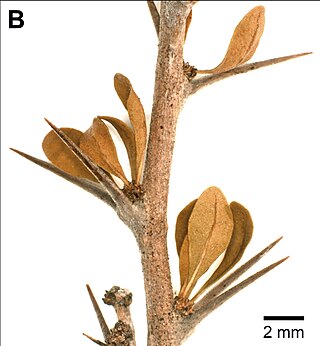
Acidocroton is a genus of plants under the family Euphorbiaceae first described with this name in 1859. It is native to Colombia and the Greater Antilles.

Moa is a municipality and an industrial city in the Holguín Province of Cuba. Its name is believed to mean "water here".

Hemithrinax is a genus of palms that is endemic to eastern Cuba. It comprises three species and one variety and was previously included within the genus Thrinax.
Lasiocroton harrisii is a species of plant in the family Euphorbiaceae. It is endemic to Jamaica and grows in thickets on limestone hills in a narrow altitudinal band.
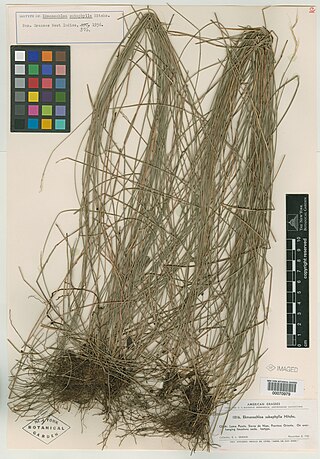
Ekmanochloa is a genus of plants in the grass family endemic to Cuba.

The Cuban pine forests are a tropical coniferous forest ecoregion on the Caribbean islands of Cuba and Isla de la Juventud. They cover an area of 6,400 km2 (2,500 sq mi), occurring in separate sections in eastern Cuba and western Cuba and Isla de la Juventud.

Nicaro-Levisa, also Levisa-Nicaro, is a Cuban town and consejo popular of the municipality of Mayarí, in Holguín Province, formed by the settlements of Nicaro and Levisa. With a population of about 20,000, it is the most populated village in the municipality after Mayarí.

Nipe-Sagua-Baracoa, also known as Macizo Nipe Sagua Baracoa, is a mountain range of eastern Cuba.
Garciadelia is a plant genus of the family Euphorbiaceae first described as a genus in 2010. The entire genus is endemic to the Island of Hispaniola in the West Indies (divided between Haiti and the Dominican Republic. It is a member of the Leucocroton alliance, which also includes Leucocroton and Lasiocroton. Species in this alliance are dioecious.
- Garciadelia abbottiiJestrow & Jiménez Rodr. - Dominican Republic
- Garciadelia castilloaeJestrow & Jiménez Rodr. - Dominican Republic
- Garciadelia leprosa Jestrow & Jiménez Rodr. - Haiti, Dominican Republic
- Garciadelia mejiaeJestrow & Jiménez Rodr. - Dominican Republic
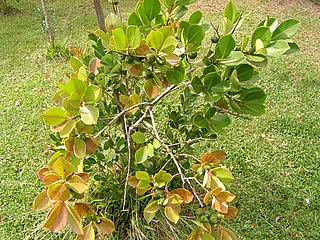
Mosiera is a genus of shrubs and small trees in the family Myrtaceae, first described as a genus in 1933. It is native to Mexico, Guatemala, the West Indies, Brazil, and Florida.

Leucocroton havanensis is an endemic species to Cuba. It is located on serpentine soils and limestone rock in the western and central part of the country. It is an evergreen tree that has dioecious flowering, meaning the species has distinct male and female individuals. The plant only grows on a small serpentine island.
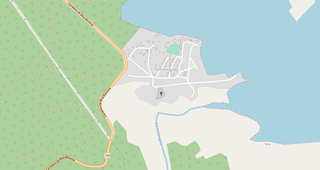
Yamanigüey is a Cuban village and consejo popular of the municipality of Moa, in Holguín Province. In 2009 it had a population of 2,394.
Dasytropis is a species of flowering plant belonging to the family Acanthaceae. It is a climbing shrub native to the Sierra de Nipe in eastern Cuba. It is the sole species in genus Dasytropis.













